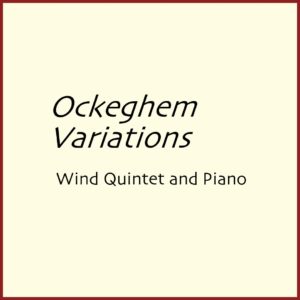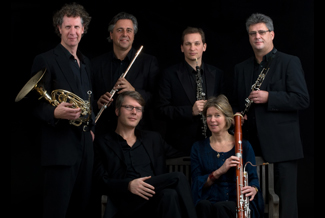Ockeghem Variations has a history that begins in Amsterdam, where I was travelling with my husband Michael, and where I met flutist Wout van den Berg, the director of the Hexagon Ensemble, as well as a couple of his colleagues. I knew of the group’s broad repertoire, and we discussed the possibility of my composing a new piece for the entire ensemble, wind quintet plus piano. Some time later, they moved ahead with the commission, and we began discussing the project in detail. I started thinking about the rich history of the Flemish Renaissance composers, and, in particular, Ockeghem. I have long been taken with his music. I focused on the Prolation Mass, with its amazingly fluid surface, and intricate underpinnings. And, like Josquin in his Nymphes des Bois, a memorial tribute to Ockeghem, I decided to symbolically represent Ockeghem’s name in my music. While Josquin chose to make the total number of notes correspond with the numeric representation of Ockeghem’s name (exchanging each letter for the numberrepresenting its place in the alaphbet, for a total of 64), I based the pitches on these numbers, creating a seven note scale.
My awareness of Josquin’s use of the name came from Willelm Elder’s fascinating book, Symbolic Scores – highly recommended! In working through my own scheme, I gradually add back the ‘missing’ pitches to create a full chromatic spectrum. There are overt allusions to the Missa Prolationum in movements one and four. Rather than a traditional set of variations based on a specific theme or progression, the five movements include variations on his name. They can be heard as a meditation on, and personal response to, his music. The first, Lustrous, has the most overt link to Ockeghem’s own music, opening a window onto one of his cadential moves. The second, Ringing, has the motion of ringing bells, associated with the religious elements of his mass. The third, Electric, breaks up particles of light into dancing waves. The fourth, Floating, opens a sonic window, giving a hint of the Ockeghem mass, while the fifth, Resounding, is a celebration of Ockeghem’s spirit. The Hexagon Ensemble recorded the piece on their Dutch Connection CD. David DeBoor Canfield, writing in Fanfare, said “….She writes in the most advanced style among these five works….but her writing is accessible and sustains interest throughout….This is the most distinctive work on the CD, and is an excellent choice to close the recital, as Shatin’s imaginative music will resonate in my mind for some time.”
-

Ockeghem Variations
From: $45.00

